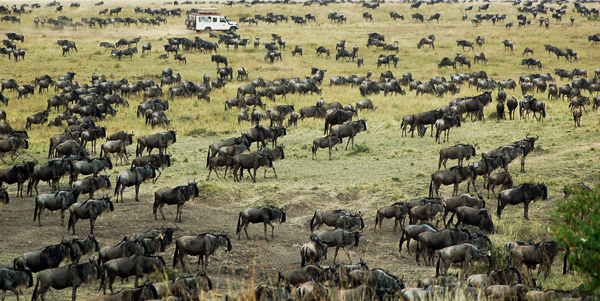The annual wildebeest migration does not just happen once a year as the name might suggest. Like a summer festival, a lot of people believe the annual wildebeest migration sets up in the northern Serengeti and Masai Mara between July and October and then disbands for the rest of the year. But, where do all those Wildebeest and Zebra go for the rest of the year?
A more accurate name for the migration may be the “continuous wildebeest migration”. What really happens is that the majority of wildebeest and zebra keep moving around the Serengeti and Masai Mara eco-system in a huge clockwise direction. They can always be found somewhere in this vast migratory region. For example, from November to March they are normally in the southern Serengeti; and between April and June they are usually found heading north along the western corridor of the Serengeti and in the Grumeti Reserve.
Predicting the exact location of the migration is not straight forward. It is all influenced by weather patterns. The rains will affect the supply of standing water and grass and the wildebeest and zebra will react accordingly.

Unusual weather patterns will cause the herds to move in unpredictable patterns, back-tracking or bypassing areas they may have visited in a previous year. The main body of the migration generally follows a roughly similar route on an annual basis, but the timing can vary. Also, there are lots of subsidiary movements of herds as the migration splits, rejoins, spreads out or congregates. It is a fluid motion that is not completely predictable.
Global warming may play a part in future migration patterns. In 2007, heavy flooding of the entire Serengeti and Masai Mara resulted in a high number of wildebeest drowning and affected the movements of the migration. The best way to understand the migration is to look at the previous years movements. This will give you a fair idea of where the migration was at any point in time. Our migration blog tracks the movement as it goes through this vast eco-system.
There are a few ways to ensure you see the migration:
• You can be fairly sure to see the migration in the Masai Mara from August to October. This is high season as this is when the wildebeest cross the Mara River.
• Ask your travel agent to book a mobile tented camp in the Serengeti. These mobile camps, as the name suggests, move with the migration throughout the year, giving the best chance of being close to the migration.
• Book two camps in different areas of the Serengeti. You would be really unlucky to not get at least one camp close to the migration. The other camp would offer something different – resident game and a safari experience away from the migration. There is always good resident game in the Serengeti so you will get some variety.
If you are need assistance planning your travel to see the migration, please click here to contact one of our consultants who are experts in arranging vacations to see the migration.



